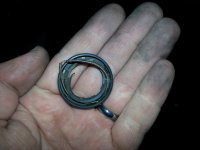ralphius
1 mW
- Joined
- Mar 3, 2019
- Messages
- 15
My Crystalyte 408 rear hub motor has stopped working after some recent rain. I've diagnosed that the windings and connectors are ok, but the hall sensors are not switching anymore. I've never had this motor apart before and I bought it second hand. I'm guessing it's about 10 years old and has been on at least three different bicycles.
So, how do I get the damn thing apart? It looked easy yesterday, just undo the 6 bolts with an allen key. I've also managed to wiggle out the white (Nylon?) piece that the wires go through.
I had a brainwave to use a bearing puller between the disc brake and the axle, see photo below:

Unfortunately this has simply bent the arms of my disk brake where I had the bearing puller hooked in :-(
Can I check I'm doing the right thing here? Any suggestions of what I'm doing wrong?
So, how do I get the damn thing apart? It looked easy yesterday, just undo the 6 bolts with an allen key. I've also managed to wiggle out the white (Nylon?) piece that the wires go through.
I had a brainwave to use a bearing puller between the disc brake and the axle, see photo below:

Unfortunately this has simply bent the arms of my disk brake where I had the bearing puller hooked in :-(
Can I check I'm doing the right thing here? Any suggestions of what I'm doing wrong?


